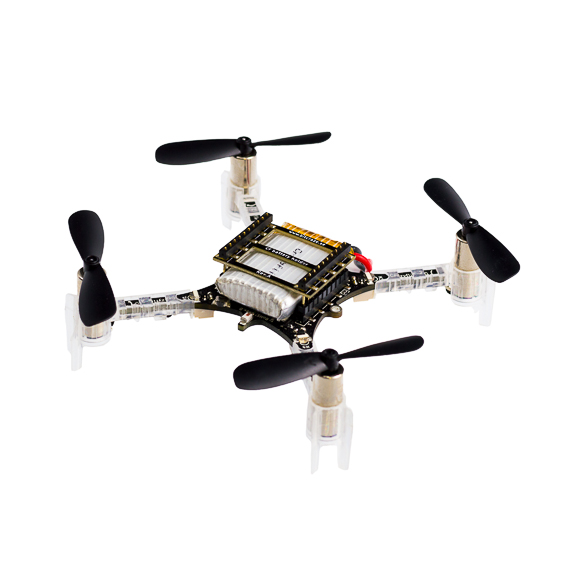Packed with functionality
It’s not only a good flyer, the Crazyflie 2.0 is also equipped with low-latency/long-range radio as well as Bluetooth LE. This gives you the option of downloading our app and using your mobile device as a controller or, in combination with the Crazyradio 2.0 or Crazyradio PA, using your computer to display data and fly with a game controller.
The Crazyflie 2.0 is charged via uUSB so you don’t need an additional charger, you just connect it to your computer.
The board contains an EEPROM memory for storing configuration parameters and a 10-DOF IMU with accelerometer, gyro, magnetometer and a high precision pressure sensor.
Your imagination sets the limits
We designed the Crazyflie 2.0 to be as flexible as possible. For us, this meant adding as many features as we could fit and writing firmware made to be modified. In addition to the default functionality that comes with the Crazyflie 2.0 we added a flexible expansion interface where a variety of expansion decks can be attached, both on the top and the bottom of the Crazyflie 2.0. From this expansion interface the user can access buses such as UART, I2C and SPI as well as PWM, analog in/out and GPIO.
Weight matters
Having a nano quadcopter that weighs only 27g has many advantages. The size makes it ideal for flying inside a lab, office, or your living room without trashing half the interior. Even though the propellers spin at high RPMs, they are soft and the torque in the motors is very low when compared to a brushless motor.
The Crazyflie 2.0 is quite fast if you let it be, but even if it crashes it’s still only 27g which means the kinetic energy involved in a crash is fairly low. During hard impact, the system is designed to break at the cheapest component, the motor mounts, which are available as spare parts.
Small size, big performance
The Crazyflie 2.0 features 4 x 7mm coreless DC-motors that give the Crazyflie a maximum takeoff weight of 42g. This capacity enables it to carry multiple expansion decks, maybe with one of your own experiments. Performance parameters can be set in real-time from our clients. By tuning these parameters you control the angles of the platform. Set them high to give you more speed and aggressiveness when flying, or set them low to make flying easier to learn when starting out.
Designed with development in mind
We think that a development platform should be something more than just making the code available, therefore our software, firmware and utilities have functionality such as logging, real-time parameter setting and wireless firmware updates. The complete development environment for most of the subsystems is available in a virtual machine, so you don’t need to install any tool chains to start developing. Also the virtual machine works just as well for flying.
Once you have made some modifications, simply flash the new firmware over the radio and you are ready to go. For those interested in more advanced development, there is a development adapter kit that supports an easy JTAG/SWD connection to both of the MCUs on the Crazyflie 2.0.
Open source
The Crazyflie 2.0 is an open source project, with source code and hardware design both documented and available. Since all of our development tools are open source (except for iOS) we are allowed to redistribute them in an easy way for our users. Aside from the firmware and software projects, there are a number of community supported APIs written in Java, Ruby, C/C++, C# and Javascript.
Something for everyone
There are ample opportunities to play with the code regardless of which language you prefer. Our client API is written in Python, while there are many other client-side implementations on GitHub written in Ruby, C#, C/C++, JavaScript, Node.JS, Cylon.JS or Java. Or, why not clone our iOS repository and get into some ObjectiveC/Swift.
If you are into embedded systems, the STM32F405 has a lot of processor power you can use for doing experiments, making improvements and adding new features. The expansion decks allow you to experiment, prototype and design your own hardware.
Take a look in the Development section to get started.
By the way, it’s fun to just fly it too!
Always evolving
We continuously work on the firmware, software, documentation and new, creative ways of using the system. We also design new expansion decks that add new functionality, and possibilities and expands the Crazyflie ecosystem. The platform supports wireless firmware updates via radio and Bluetooth LE, so when a new firmware is released, it’s a breeze to update.
Projects
Resources
- Start here
- Development overview
- FAQ
- Getting help
- Datasheet
- Schematics
- Expansion decks of the Crazyflie 2.x
Tutorials
Getting started with the Crazyflie 2.0 or Crazyflie 2.1(+)
If you have any further questions please contact support@bitcraze.io
